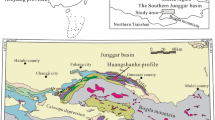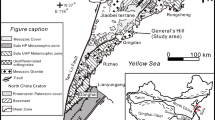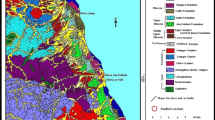Abstract
Six tektites from Guilin of Guangxi, Hainan, and Guangdong were analyzed for the abundances of major elements and 27 trace elements. All samples are splash-form tektites and have SiO2 contents ranging from 73.1wt% to 76.0wt% (74.6wt% on average). The chemical compositions, except Cr and Ni, of tektites from different areas, are similar. Guangdong tektite shows enrichments of Ni and Cr contents by a factor of 3, and has slightly higher MgO and FeO than Hainan and Guilin tektites. It indicates that the tektites were formed by mixing several target rocks. The major and trace element concentrations of southern China tektites closely resemble previously reported data for average splash-form and Muong Nong-type indochinites, indicating that they have the same source. (La/Lu)CI (7.99), Zr/Hf (35.45 on average), Ba/Rb (3.59 on average), and the rare earth element (REE) contents of tektites are similar to those of typical post Archean upper crustal rocks. This study suggests that the best fit for the target source of southern China tektites could be a combination of 41% shale, 2% sandstone, 20% greywacke, and 37% quartzite.
Similar content being viewed by others
References
Storzer D, Wagner G A. Fission-track ages of North American tektites. Earth Planet Sci Lett, 1971, 10: 435–440
Glass B P, Koeberl C, Blum D J, et al. A Muong Nong-type Georgia tektite. Geochim Cosmochim Acta, 1995, 59: 4071–4082
Staudacher T, Jessberger E K, Dominik B, et al. 40Ar-39Ar ages of rocks and glasses from the Nördlinger Ries and the temperature history of impact breccias. J Geophys, 1982, 51: 1–11
Laurenzi M A, Bigazzi G, Balestrieri M L. 40Ar/39Ar geochronology of central European tektites (moldavites). Meteorit Planet Sci, 2003, 38: 887–893
Koeberl C, Bottomley R, Glass B P, et al. Geochemistry and age of Ivory Coast tektites and microtektites. Geochim Cosmochim Acta, 1997, 61: 1745–1772
Izett G A, Obradovich J D. Laser-fusion 40Ar/39Ar ages of Australasian tektites (abstract). Lunar Planet Sci, 1992, 23: 593–594
Glass B P. Tektites and microtektites: Key facts and inferences. Tectonophysics, 1990, 171: 393–404
Lee M Y, Wei K Y. Australasian microtektites in the South China Sea and the western Philippine Sea: Implications for age, size and location of the impact crater. Meteorit Planet Sci, 2000, 35: 1151–1155
Lacroix A. Les tectites sans formes figuree de I’Indochine. C R Acad Sci Paris, 1935, 200: 2129–2132
Koeberl C. Geochemistry and origin of Muong Nong-type tektites. Geochim Cosmochim Acta, 1992, 56: 1033–1064
Wasson J T. Layered tektites: A multiple impact origin for the Australasian tektites. Earth Planet Sci Lett, 1991, 102: 95–109
Blum J D, Papanastassiou D A, Koeberl C, et al. Nd and Sr isotopic study of Australasian tektites: New constraints on the provenance and age of target material. Geochim Cosmochim Acta, 1992, 56: 483–492
Koeberl C. Tektite origin by hypervelocity asteroidal or cometary impact: Target rocks, source craters, and mechanisms. In: Dressler B O, Grieve R A F, Sharpton V L, eds. Large Meteorite Impacts and Planetary Evolution. Colorado: Geological Society of America, 1994. 133–152
Koeberl C, Poag C W, Reimold W U, et al. Impact origin of the Chesapeake Bay structure and the source of North American tektites. Science, 1996, 271: 1263–1266
Engelhardt W V, Luft E, Arndt J, et al. Origin of moldavites. Geochim Cosmochim Acta, 1987, 51: 1425–1443
Koeberl C, Reimold W U, Blum J B, et al. Petrology and geochemistry of target rocks from the Bosumtwi impact structure, Ghana, and comparison with Ivory Coast tektites. Geochim Cosmochim Acta, 1998, 62: 2179–2196
Stauffer P H. Anatomy of the Australasian tektite strewn field and the possible site of its source crater. In: Proceedings of the 3rd Regional Conference on Geology and Mineral Resources of Southeast Asia, Bangkok, Thailand, 1978. 285–289
Schnetzler C C. Mechanism of Muong Nong-type tektite formation and speculation on the source of Australasian tektites. Meteoritics, 1992, 27: 154–165
Glass B P, Wu J. Coesite and shocked quartz discovered in the Australasian and North American microtektite layers. Geology, 1993, 21: 435–438
Hartung J B, Koeberl C. In search of the Australasian tektite source crater: The Tonle Sap hypothesis. Meteoritics, 1994, 29: 411–416
Ma P, Aggrey K, Tonzola C, et al. Beryllium-10 in Australasian tektites; constraints on the location of the source crater. Geochim Cosmochim Acta, 2004, 68: 3883–3896
Xu H Q, Hu G H, Zhong H H, et al. A preliminary study on the chemical composition of qionglei tektites in China (in Chinese). Geochemistry, 1983, 3: 322–328
Lee Y T, Chen J C, Ho K S, et al. Geochemical studies of tektites from East Asia. Geochemical Journal, 2004, 38: 1–17
Ho K S, Chen J C. Geochemistry and origin of tektites from the Penglei area, Hainan Province, southern China. J Southeast Asian Earth Sci, 1996, 13: 61–72
Hsu W, Guan Y, Wang H, et al. The lherzolitic shergottite Grove Mountains 99027: Rare earth element geochemistry. Meteorit Planet Sci, 2004, 39: 701–709
Zinner E, Crozaz G. A method for the quantitative measurement of rare earth elements in the ion microprobe. Int J Mass Spectr Ion Processes, 1986, 69: 17–38
Chapman D A, Scheiber L C. Chemical investigation of Australasian tektites. J Geophys Res, 1969, 74: 6737–6794
Koeberl C. The geochemistry of tektites: An overview. Tectonophysics, 1990, 171: 405–422
Palme H, Beer H. Abundances of the elements in the solar system. In: Voigt H H, ed. Landolt-Börnstein, Group VI: Astronomy and Astrophysics: Instruments; Methods; Solar System. Berlin: Springer, 1993. 196–221
Glass B P, Pizzuto J E. Geographical variation in Australasian microtektite concentrations: Implications concerning the location and size of the source crater. J Geophys Res, 1994, 99: 19075–19081
Amare K, Koeberl C. Variation of chemical composition in Australasian tektites from different localities in Vietnam. Meteorit Planet Sci, 2006, 42: 107–123
Barnes V E, Pitakpaivan K. Origin of indochinite tektites. Proc Nat Acad Sci USA, 1962, 48: 947–955
Wasson J T. A multiple-impact origin of Southeast Asian tektites. Lunar Planet Sci, 1987, XWI: 1062–1063
Taylor S R, McLennan S M. The Continental Crust: Its Composition and Evolution. Oxford: Blackwell Scientific Publications, 1985. 312
Zhang F, Huang Z T, Mo J Y. Fission track ages of tektites from Bobai and Baso Basin in Guangxi, China (in Chinese). Chin Sci Bull, 1994, 15: 1396–1398
Liu S S, Zhang F. Dating by Fission Tracks. Beijing: Geological Publishing House, 1985. 12–13
Yan Z, Yuan B Y, Ye L F. Spaltspurendatierung and Hainan-inseltektiten (Legungmo) (in Chinese). Sci Geol Sin, 1979, 1: 37–42
Fleischer R L, Price P B. Glass dating by fission fragment tracks. J Geophys Res, 1964, 69: 331–339
Suess F E. Die Herkunft der Moldavite und verwandter Gläser. Jahrb Geol Reichsanstalt, 1900, 50: 193–382
O’Keefe J A. The origin of tektites. Meteoritics, 1994, 29: 73–78
Nicolaysen L O. Tektites: Ejecta from massive cratering events, caused by periodic escape and detonation of deep mantle fluids. In: International Workshop Cryptoexplosions and Catastrophes in the Geological Record, Parys, South Africa, 1987. 15
Wampler J M, Smith D M, Cameron A E. Isotopic comparison of lead in tektites with lead in earth materials. Geochim Cosmochim Acta, 1969, 33: 1045–1055
Serefiddin F, Herzog G F, Koeberl C. Beryllium-10 concentrations of tektites from the Ivory Coast and from Central Europe: Evidence for near-surface residence of precursor materials. Geochim Cosmochim Acta, 2007, 71: 1574–1582
Condie K C. Chemical composition and evolution of the upper continental crust: Contrasting results from surface samples and shales. Chem Geol, 1993, 104: 1–37
Sato T. Regional geology and stratigraphy: Southeast Asia and Japan. In: Westermann G E G, ed. The Jurassic of the Circum-Pacific. Cambridge: Cambridge University Press, 1992. 194–213
Wasson J T, Heins W A. Tektites and climate. J Geophys Res, 1993, 98: 3043–3052
Wasson J T. Large aerial bursts: An important class of terrestrial accretionary events. Astrobiology, 2003, 3: 163–179
Ridd M F. The Mesozoic: Thailand. In: Moullade M, Nairn A E M, eds. The Phanerozoic Geology of the World II. New York: Elsevier, 1978. 145–161
Meisel T, Koeberl C, Ford R J. Geochemistry of Darwin impact glass and target rocks. Geochim Cosmochim Acta, 1990, 54: 1463–1474
Author information
Authors and Affiliations
Corresponding author
Rights and permissions
About this article
Cite this article
Lin, S., Guan, Y. & Hsu, W. Geochemistry and origin of tektites from Guilin of Guangxi, Guangdong and Hainan. Sci. China Earth Sci. 54, 349–358 (2011). https://doi.org/10.1007/s11430-010-4146-1
Received:
Accepted:
Published:
Issue Date:
DOI: https://doi.org/10.1007/s11430-010-4146-1




